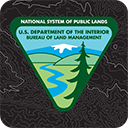BLM thins trees improving eastern Nevada sagebrush communities
Chris Hanefeld, Public Affairs Specialist. Photos by Kellie Dobrescu.
The BLM is masticating, or mechanically shredding pinyon-pine and juniper to re-establish sagebrush communities, improve wildlife habitat and reduce fire potential on 450 acres of recently seeded public land in White Pine County, Nev.
“We chose mastication because it allows us to remove the encroaching trees without damaging adjacent species, such as mountain mahogany. Also, the resulting biomass will serve as mulch for seed we applied earlier this year,” said Cody Coombs, BLM Ely District fuels program manager.
The fuels program in January aerially distributed 4,400 pounds of seed over the project area located in Egan Basin, 50-plus miles north of Ely. Five native and two non-native or introduced species made up the mix of grasses and forbs. Native grasses and forbs applied were bluebunch and thickspike wheatgrass, indian ricegrass, western yarrow and palmer’s penstemon. Introduced were Siberian wheatgrass and small burnet, a forb, to support soil stability and provide for erosion control.
“Seed mixes are based on site conditions and use. Native seed is the priority. However, non-native seed is used depending on the availability of native seed, site characteristics, and risk of invasive species establishment,” explained Range and Wildlife Conservationist Kellie Dobrescu.
Tree-thinning will soon stop for migratory bird nesting season. Operations will resume in late July or early August.
The seeding and tree-thinning are components of the landscape-scale Egan and Johnson Basins Restoration Project, a multi-year plan to restore and maintain watershed health while reducing risk of catastrophic wildfire by treating up to 24,346 acres of an 84,675-acre project area.
